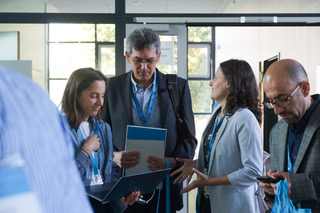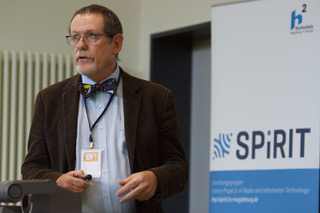The Digital Future of Teaching and Learning – SPiRIT organized International Conferences in Magdeburg
The auditorium of the Magdeburg-Stendal University of Applied Sciences transformed into an international conference center from 23rd until 27th September – Academics in Engineering Sciences came from all over the world to exchange about Education Technologies research.
An international team has hosted two sequential international conferences, one symposium and numerous workshops under this year’s scientific and organizational direction of Local Chair Prof. Michael A. Herzog. Directed by the two Co-Chairs Leonore Franz and Veronika Weiß, the research group SPiRIT implemented new ideas and inspiring formats in order to create a creative and personal atmosphere for the guests on Magdeburg campus. Within this ambiance, new technologies, conceptions, approaches, and viewpoints have been presented, discussed, and constructively evolved beyond the scientific lectures in the auditorium and conference rooms.
On Monday 23rd September, the conference week started with the ‘ICWL – 18th International Conference on Web-Based Learning’ combined with the ‘4th International Symposium on Emerging Technologies for Education – SETE’ both setting focus on the research results of Technology Enhanced Learning and Future Technologies in Education. Thematically following, the ‘ITHET – 18th International Conference on Information Technology Based Higher Education and Training’ took place, starting on 26th September, with the main focus on digital teaching in higher education of engineering sciences.
More than 300 international scientists from 36 countries traveled to the conferences on our campus. Renowned keynote speakers presented their research results and visions on topics like machine learning, analysis of learning data, collaborative virtual learning as well as competencies of future degree holders. An exceptionally engaged discussion was dedicated to the topic, how the university as an institution should continue to develop: Away from synchronous classroom learning for all students. Towards individualized, research-oriented learning. Promotion of specialized, problem-focused education. Institutionalized cooperation of specialist disciplines and mindsets to foster interdisciplinary competencies starting from the first semester.


Amelie Ries spoke to Prof. Herzog about his résumé of the conference marathon.
What progress from the laboratories around the world, that have been presented over the last few days, particularly touched you?
“The advances in artificial intelligence and data analysis methods, the many improvements of digital groupwork cooperation, but also the quality of individual learning and experiencing in virtual worlds have developed at a surprising rate. They are already giving us some new means to adapt our teaching and learning cultures to the latest challenges in society, business, and science.”
What exactly do you remember?
“We see, for example, how a combination of intelligent chatbots and mixed reality enables new forms of guided learning with the use of robots and avatars. The virtual, intelligent tutor robot was presented as technically feasible. So, the only question left is how intelligent such a virtual, individual teacher can be in foreseeable time. Question-answering functions are well-known from Alexa & Co. They are working as a simple search engine, just with speech functions.
But is such a robot-teacher capable of doing more than responding to questions and providing content? Can it guide and inspire us?
“As we see, it can guide and also push us, because the collected data provides information on our learning progresses in certain tasks, it recognizes our emotions via camera and evaluates our eye movements or changes of location. Consequentially, the robot-teacher uses already know patterns to determine appropriate next steps for us as learners. It can make an offer but can also playfully motivate the user compared to the way computer games already do. Of course, it can also give us tasks and lead us to specific objectives.
And where can we find the inspiration that brings us humans onto new paths, and that motivates us?
“Getting real inspiration from a robot is not yet tangible. How is a robot supposed to inspire us creatively? From what data could he derive this from? It will be extremely tough to generate that kind of training data from today’s point of view.
If we turn the whole thing around and take a look at the learner as an avatar, then it looks different again. At the conference, I was especially impressed by Kavita’s example. Although she is tied to her home environment due to her illness, telepresence via a robot has given her the freedom to move around, to study at a university college, and to graduate with a doctorate in computer science. Such an example is so inspiring for us as developers.”
What does the availability of this technology mean for further development of teaching at schools and universities?
“Our current university system still demands vast amounts of factual knowledge from students in many areas, even though quality-assured facts are technically already available everywhere and every time within seconds. If today’s intelligent machines already create better and more individual learning experiences for competence development than a teacher can achieve in front of a heterogeneous class, why don’t we change the role of the teacher into a moderator of learning processes? Why do many teachers not yet see themselves as developers of social competences, promoters of team skills, coaches for personality development, and inspirers for real educational experiences?
Educational technologies provide us so many new opportunities to overcome barriers between disciplines and places: Training in interdisciplinary, space-spreading cooperation, Obtaining complex interdisciplinary progress with the use of organization methods, technical understanding, and tools. All of this could be promoted better and better by educational technologies, as the contributions of researchers and developers to our conferences have impressively shown.”
Shouldn’t this cultural change also be structurally supported by university institutions? For example, with interdisciplinary study programs and multidisciplinary research?
“New study programs, in which methodological knowledge, critical and discursive skills, professional, technical and social experiences, as well as the connecting design techniques are the main focus, are long overdue and they are strongly promoted currently in the US and Canada. Janusz Kozinski from Brock University demonstrated a fine example of the strategic realignment of a university. Here, all new courses are offered interdisciplinary, such as a design-oriented, customizable study program in »Sciences«. From here, very different career paths can be developed. We have seen new interdisciplinary study programs in the engineering sciences, for example, at the University of Maryland, where Keith Bowman confronted us with accompanying research, such as teambuilding. Assisted, inclusive learning under the support of technology has real disruptive potential. In times of demographic change and declining student numbers, I see excellent opportunities for universities to differentiate with individualizable, interdisciplinary offerings, following the motto ‘Build you own Menu’.”
How can a university teacher react to this development?
“Our companies also need graduates from us with a universal understanding. That is about approaches, tools, and social interaction in order to accelerate the deployment and the implementation of fast-changing technologies. We want and need to solve our major societal challenges faster. Every one of us, whether we are a teacher, employee, student, or pupil, we want to and can contribute according to our abilities. Constant development for everyone is desired. The individualization of learning, lifelong development of new competencies and skills, all this is supported by educational technologies more effectively than ever before. It is helpful for every teacher and learner to take a closer look at new learning technologies, and to question personal concepts of use. The digitization of teaching can also encourage cooperation between teachers to initiate more beneficial approaches. From my own experience, I can prove that advancing this new teaching and learning culture together in an interdisciplinary way gives much inspiration, surprising results, and enormous fun!”
The summaries of the contributions, recordings of the main lectures as well as photos of the conferences can be found on the websites of ICWL/SETE and ITHET.